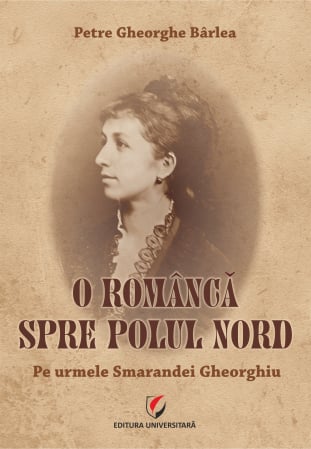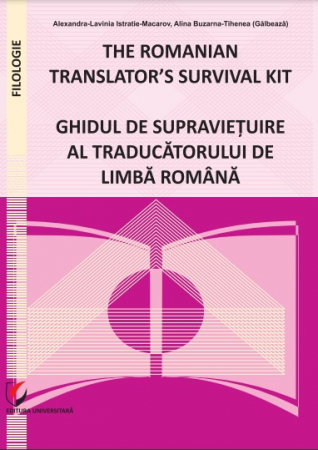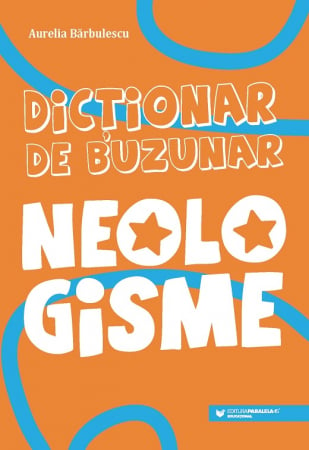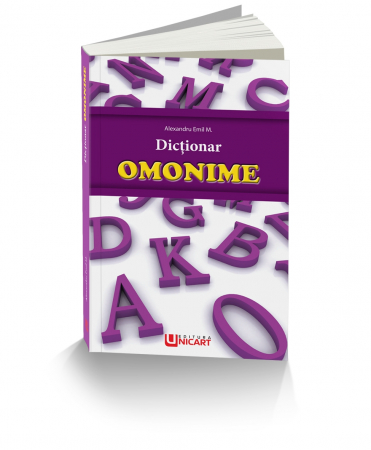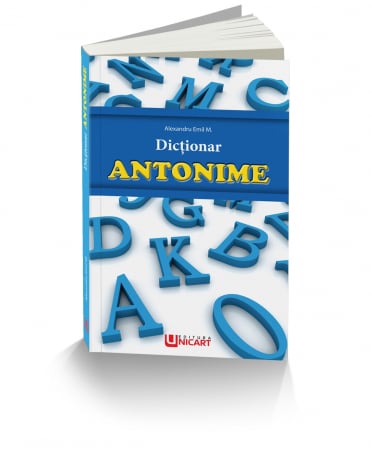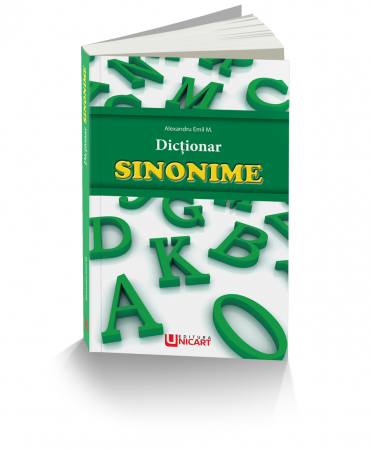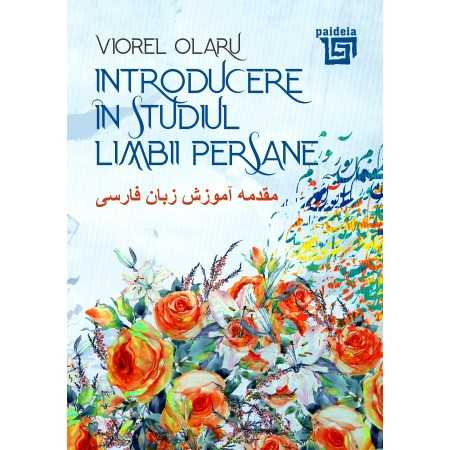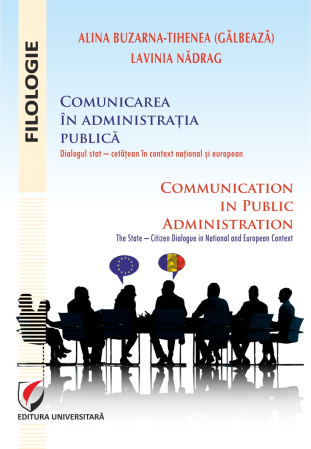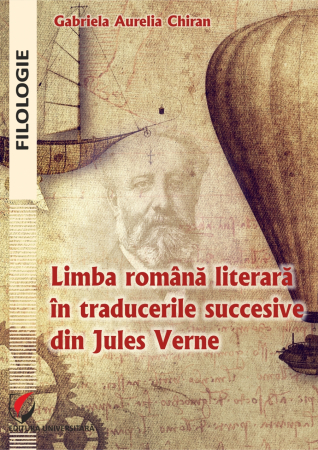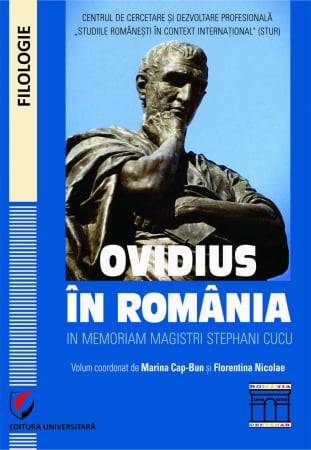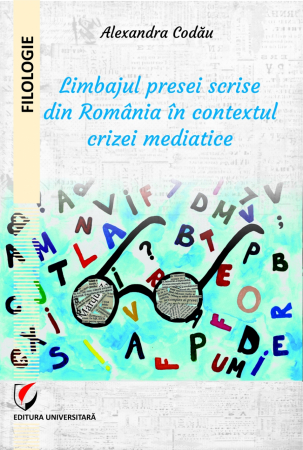Manuscript proposals: [email protected] / 0745 204 115 //// Tracking orders Individuals / Sales: 0745 200 357 / Orders Legal entities: 0721 722 783
Publisher: Editura Universitară
Author: Petre Gheorghe Barlea
Edition: revised
Pages: 436
ISBN: 978-606-28-1644-5
DOI: https://doi.org/10.5682/9786062816445
Publisher year: 2023
Product Code:
9786062816445
Do you need help?
0745 200 357
- Description
- Download (1)
- Authors
- Content
- More details
- Reviews (0)
This work was published for the first time in the volume Petre Gheorghe Barlea, Pe urmele lui Grigore Alexandrescu, Bucharest: E.S.‑T, 1984. Book editor: Valentin Borda, cover by Mihai Valeriu Surcel. The scientific references of the book were Prof. univ. Dr. Paul Cornea and University Lecturer Mihai Moraru (today, Prof. Dr.), both from the University of Bucharest. The current edition appears with the support of the Municipality of Tirgoviste, to which the author and editors express their thanks.
The transcription of the text from the old edition, using the OCR technique, was made by Prof. Dr. Constantin-Georgel Stoica. Corrections of text or infrapage notes, changes and additions of information or interpretation belong to the author. Our annotations have been marked with (n. ed. = editor's note). The illustration was made by capitalizing on several sources: the recovery of some images from the first edition, in parallel with the reconstruction of the text; recent photographs, taken and processed by Petre‑Tudor Barlea and C‑tin G. Stoica; images taken from the print fund of Targoviste City Hall, through the Tourism Promotion Department, of the National Museum Complex "Curtea Domneasca" or from personal archives. We must specify that for making the photocopies of the first edition, the author benefited from the support of the professor, the painter and the noteworthy art photographer Constantin Mazuru. Obviously, the last series of processing were carried out by the graphic specialists and techno-editors of the Bucharest University Publishing House. Our words of gratitude are fully due to all of them.
The transcription of the text from the old edition, using the OCR technique, was made by Prof. Dr. Constantin-Georgel Stoica. Corrections of text or infrapage notes, changes and additions of information or interpretation belong to the author. Our annotations have been marked with (n. ed. = editor's note). The illustration was made by capitalizing on several sources: the recovery of some images from the first edition, in parallel with the reconstruction of the text; recent photographs, taken and processed by Petre‑Tudor Barlea and C‑tin G. Stoica; images taken from the print fund of Targoviste City Hall, through the Tourism Promotion Department, of the National Museum Complex "Curtea Domneasca" or from personal archives. We must specify that for making the photocopies of the first edition, the author benefited from the support of the professor, the painter and the noteworthy art photographer Constantin Mazuru. Obviously, the last series of processing were carried out by the graphic specialists and techno-editors of the Bucharest University Publishing House. Our words of gratitude are fully due to all of them.
-
On the tracks of Grigore Alexandrescu
Download
PETRE GHEORGHE BARLEA studied Classical Philology and then Modern Philology at the University of Bucharest. He is an emeritus professor at the Department of Romanian Philology, Classical and Balkan Languages of the "Ovidius" University in Constanta, Romania, member of the Doctoral School of Humanities. He taught courses and delivered lectures on the Romanian language, culture and civilization, courses and conferences on general and comparative linguistics, Latin, Greek of the New Testament and theory of mentalities and cultural identities at "Carol IV" University ” from Prague (1993-1996), at Paris IV Sorbonne (2001-2003), as well as at universities and research centers in Italy, Spain, Belgium, Greece, Israel, Austria, USA, Canada, etc. He is Doctor Honoris Causa of UVT, where he founded several sections and departments in the field of speech sciences or of general interest for higher education. The didactic and scientific activity is focused on linguistic studies (Romanian, Latin and comparative), rhetoric, mythology, cultural history, interculturality. Among the published books: Peithous demiourgos (2004); Ana the Good. Linguistics and mythology (2007); Multilingualism and Interculturality (2010); Contemporary Romanian language (2013); Chaos and order. Positivist thinking and practice in the evolution of Brazilian society (2016); Translations and translators. Pages from the history of Romanian culture (2016); The truth from the inkwell. Studies of universal literature (2019); Transfigurations. Essays on Romanian literature (2020). Text editions: Eugen Lovinescu, A look at classicism (2012) s.a. Translations: A. Schopenhauer, Dialectica eristica or the art of always being right (2010). Since 2003, he publishes the academic journal "Diversité et Identité Culturelle en Europe" (DICE), included in numerous International Databases. He is the initiator of the "Latinity-Romanity-Romanity" International Colloquium, which he organizes annually, starting in 2001.
He is a member of the Romanian Writers' Union, a member of the Romanian Professional Journalists' Union and is part of several national and international associations and societies.
He is a member of the Romanian Writers' Union, a member of the Romanian Professional Journalists' Union and is part of several national and international associations and societies.
Introductory study (M.C.) / 9
Note on the edition (M.C.) / 25
Argument / 29
1. Obarsii at Targoviste / 35
1.1. House from Mahalaua Lemnului / 35
1.2. A condicar from Bucharest... / 39
1.3. "From my mother's breast..." / 44
1.4. Father's day / 58
2. Events at the beginning of the century / 62
2.1. Gardens in the possession of the cuckoos and the testimonies of the glorious past / 62
2.2. Disorders and crimes / 66
2.3. "Let the muses be honored with the fruits of learning" / 74
3. The first journey / 86
3.1. Bucharest. Vintage stamp / 86
3.2. Stop in the world of books / 96
4. In the fortress on Dambovita / 98
4.1. Friends from "Sfantul Sava" College / 98
4.2. The meeting with Iancu Vacarescu / 104
4.3. In the house of Ion Heliade Radulescu. The poetic debut / 108
4.4. Member of the Philharmonic Society / 118
4.5. Officer without vocation / 120
5. In Focsani and Braila / 125
5.1. Customs on Milcov / 125
5.2. Echoes in Paris...! / 133
5.3. Love and its effects. Metamorphosis of the Focsan landscape / 135
5.4. In Braila, meditating on the sunset glories / 138
5.5. La Ramniceni, occasional ethnographer / 142
6. Again in Bucharest / 149
6.1. In the house of Ion Bratianu and Tache Ghica / 149
6.2. Controversies with the former mentor / 152
6.3. On the road to literary consecration / 161
7. "The year 1840 / 169
7.1. The poem with the title password / 169
7.2. The time had not arrived / 184
7.3. Unwanted stop at Djurstva from Gorgani / 186
7.4. Sentimental itineraries / 195
8. Retirement to the country / 205
8.1. To Floresti and Riders / 205
8.2. Travel project to Iasi / 212
9. Souvenirs and impressions from Valea Oltului / 223
9.1. The difficulties of departure / 223
9.2. The road to Slatina and Dragasani / 227
9.3. Big pimples / 236
9.4. "Mircea's shadow. At Cozia" / 242
9.5. In the footsteps of Anton Pann / 255
9.6. Short stops in Valcen / 266
9.7. Disillusions / 268
9.8. Arnota / 273
9.9. In the fairytale world of stalactites and stalagmites / 279
9.10. "Moonrise. At Tismana" / 284
9.11. In search of local folklore / 296
10. In Buzau, in search of the muses / 304
10.1. The Creator's Dilemma / 304
10.2. The memorialist / 308
11. Cursus honorum / 316
11.1. "Finding peace in life and abundance in peace" / 316
11.2. Through the country, in the retinue of the ruler / 326
11.3. At Sinaia and Breaza / 333
11.4. Grigore Alexandrescu... editor / 338
12. From Bucharest to Focsani, for the union of the principalities / 348
12.1. "Today's head of the Archive, a loving man of peace..." / 348
12.2. "A lot can be done by the good few together!" / 366
13. A long wandering / 375
13.1. Wedding without luck / 375
13.2. The last journey of a trailblazer / 385
14. Memory of books / 390
Selective bibliography / 408
Note on the edition (M.C.) / 25
Argument / 29
1. Obarsii at Targoviste / 35
1.1. House from Mahalaua Lemnului / 35
1.2. A condicar from Bucharest... / 39
1.3. "From my mother's breast..." / 44
1.4. Father's day / 58
2. Events at the beginning of the century / 62
2.1. Gardens in the possession of the cuckoos and the testimonies of the glorious past / 62
2.2. Disorders and crimes / 66
2.3. "Let the muses be honored with the fruits of learning" / 74
3. The first journey / 86
3.1. Bucharest. Vintage stamp / 86
3.2. Stop in the world of books / 96
4. In the fortress on Dambovita / 98
4.1. Friends from "Sfantul Sava" College / 98
4.2. The meeting with Iancu Vacarescu / 104
4.3. In the house of Ion Heliade Radulescu. The poetic debut / 108
4.4. Member of the Philharmonic Society / 118
4.5. Officer without vocation / 120
5. In Focsani and Braila / 125
5.1. Customs on Milcov / 125
5.2. Echoes in Paris...! / 133
5.3. Love and its effects. Metamorphosis of the Focsan landscape / 135
5.4. In Braila, meditating on the sunset glories / 138
5.5. La Ramniceni, occasional ethnographer / 142
6. Again in Bucharest / 149
6.1. In the house of Ion Bratianu and Tache Ghica / 149
6.2. Controversies with the former mentor / 152
6.3. On the road to literary consecration / 161
7. "The year 1840 / 169
7.1. The poem with the title password / 169
7.2. The time had not arrived / 184
7.3. Unwanted stop at Djurstva from Gorgani / 186
7.4. Sentimental itineraries / 195
8. Retirement to the country / 205
8.1. To Floresti and Riders / 205
8.2. Travel project to Iasi / 212
9. Souvenirs and impressions from Valea Oltului / 223
9.1. The difficulties of departure / 223
9.2. The road to Slatina and Dragasani / 227
9.3. Big pimples / 236
9.4. "Mircea's shadow. At Cozia" / 242
9.5. In the footsteps of Anton Pann / 255
9.6. Short stops in Valcen / 266
9.7. Disillusions / 268
9.8. Arnota / 273
9.9. In the fairytale world of stalactites and stalagmites / 279
9.10. "Moonrise. At Tismana" / 284
9.11. In search of local folklore / 296
10. In Buzau, in search of the muses / 304
10.1. The Creator's Dilemma / 304
10.2. The memorialist / 308
11. Cursus honorum / 316
11.1. "Finding peace in life and abundance in peace" / 316
11.2. Through the country, in the retinue of the ruler / 326
11.3. At Sinaia and Breaza / 333
11.4. Grigore Alexandrescu... editor / 338
12. From Bucharest to Focsani, for the union of the principalities / 348
12.1. "Today's head of the Archive, a loving man of peace..." / 348
12.2. "A lot can be done by the good few together!" / 366
13. A long wandering / 375
13.1. Wedding without luck / 375
13.2. The last journey of a trailblazer / 385
14. Memory of books / 390
Selective bibliography / 408
When George Calinescu asserts about Grigore Alexandrescu that he represented "the purest conscience of the age" he had in mind, of course, less the intellectual stance involved in the revolutionary movements of 1840-1848, those that marked the beginning of social-economic modernization and spiritual aspects of Romanian life, and more so the pose of the "citizen poet", who contributed with his pen to the struggle for change in the face of the country and the people he represented.
In order to reach these two essential positions, the writer, fully validated only in the decade following the great event of the mid-19th century, crossed several initiatory paths, lived through experiences that definitively marked his existence and, through this, social history - the politics and culture of the community of which he was a part.
The paths that led to these experiences are documented in Petre Gheorghe Barlea's book, In the footsteps of Grigore Alexandrescu. Published in its first version in 1984, it is the fruit of a secondary concern in the life and work of the linguist P. Gh. Barlea, a kind of violin d'Ingres, we could say, if we did not know that, in the author's conception, linguistics cannot be separated neither from literature, nor from the analysis of everyday speech acts, of usual utilitarian communication. It is significant, in this sense, that towards the end of his scientific-didactic career, P. Gh. Barlea also published volumes of studies and literary essays, in which he collected his contributions scattered throughout his life through various academic periodicals or culture.
In fact, the passion for the study of Grigore Alexandrescu's life and work has remained alive throughout the decades and has materialized not only in the two books written in his youth, but also in countless articles and essays published in various periodicals. In the university folklore, the information circulates that Petre Gheorghe Barlea knows the entire work of Grigore Alexandrescu by heart, including his memorial prose. We heard this statement from the mouth of Prof. Univ. Dr. Lucian Chisu, current director of the "George Calinescu" Institute of History and Literary Theory of the Romanian Academy, colleague and friend of Grigore Alexandrescu's monograph. Professor Barlea himself claims that, in reality, he can reproduce by heart only a part of the great pasoptist's writings and that, anyway, time has caused significant damage to the acquisitions of his youth. It is certain that the interest in the Romanian fabulist remained undisturbed and is maintained by all kinds of data outside the permanent contact with the literary work. Locals know, for example, that the beautiful house in Targoviste of P. Gh. Barlea, with its fabulous garden and rich library, was built, almost a century ago, on the land that belonged to Aneta Alexandrescu, one of the great-granddaughters of the poet . Therefore, the impulse to reconstruct the physical and spiritual paths of Grigore Alexandrescu has a very deep internal motivation.
In the first category, that of the trips actually made, in the country (there are no documents attesting to any trip abroad, as happened with most pasoptist writers), there are three to four routes, altogether, not even very long ones. The "character" of P. Gh. Barlea's book seems rather a sedentary person, prone to imaginary journeys, in the world of ideas, words and civilizations reconfigured through the filter of famous pen handlers from all over the world. The trips to the past, after the "documentation" in the libraries of his time, became the favorite of the poet.
Otherwise, those performed physically must be judged according to the criterion of the material difficulties they entailed, especially taking into account the young age of the protagonist and the chronic lack of financial means that characterized him. It is to be assumed that, if there had not been a friend with more financial resources, like Ion Ghica, or various protectors from high society, if he had not benefited from support from the state, during his official trip to the border post in Focsani, then to Central Commission from the same city, there would not have been these few trips in the biography of Gr. Alexandrescu. However, the stake of P. Gh. Barlea's book aims at the strong impact that these travels in space had on the formation of the personality of the Romanian writer. Again, we have to look at things from the perspective of time, in a double sense: on the one hand, the traveler is at the age of great spiritual acquisitions, that is, in full process of formation and maturation of his intellectual-professional individuality; on the other hand, the history of the country where the trips took place is in a process of renewal on all levels, with a very favorable dynamic for the generation of young people connected to the reality of their era.
The first trip was the shortest, but the most important in Grigore Alexandrescu's life. It is the one that definitively marked his destiny. Practically, the 15-year-old teenager traveled with the postalion the distance of not even 80 kilometers between his hometown Targoviste and Bucharest, the town where he will spend the rest of his life.
In the family of the treasurer Mihai Alexandrescu, an official at the Prefecture, then at the Targoviste City Hall, the atmosphere had become hard to bear for a hypersensitive boy like Grigore, the fourth of five children from his first marriage. After the death of his wife, Maria Fusea-Alexandrescu, a descendant of the local aristocracy, same Alexandrescu Mihai remarried, bringing his new wife's children into the house. The conflicts were almost inherent and, for a while, the sensitive and introverted teenager sought solace by taking refuge among the ruins of the voivodeship fortress, at the Royal Court in Targoviste or on the hills outside the city, at the Dealu Monastery, where the family also owned a plantation with vines and several fruit trees. An even more comfortable refuge was in the pages of books and on the benches of the private schools of teachers Rafail and Mitilineu. Then, one fine day, the young man hastily packed a few bags and set off for Bucharest, where he was installed by his father's brother, Monk Ieremia, in a cell of the Metropolitanate of Bucharest. After a while, his father also died, so he had no place to return "home" until later, when his brothers and sister made a point in life. The young man had learned books in Romanian, Greek and French. He had already thoroughly studied texts from Sophocles and Euripides, and the modern editions of Anacreon were read and learned "cover to cover". But here, in Bucharest, he had great encounters with literature and art, with the enlightened spirits of the Romanian and foreign worlds, which marked him for the rest of his life. First, even before enrolling in the school at St. Sava, he discovered a huge amount of books, stored without any order, in the attic of the Metropolis. He read voraciously, until his eyes were blinded, first by chance, then looking for texts belonging to the same author, the same era, following a certain literary genre, a certain species, a specific theme, etc. Voltaire, Boileau, Racine, Montesquieu were added to the readings of Xenophon, Thucydides, Plutarch, which completed the list of the ancients (especially the Greek tragedians) attended previously.
Then he was enrolled in the French School of A. J. Vaillant, which would soon be integrated into the structure of the College of "St. Sava". Among his colleagues, Ion Ghica, Nicolae Balcescu, the Voinescu brothers, the Campineanu brothers s.a. drew his attention. Among the teachers – Eufrosin Poteca, Simion Marcovici, Petrache Poenaru, G. Ioanid s.a. In the class of letters, he widened and deepened the area of contacts with the great universal literature. The impact was particularly strong. A third is added to the first two circumstances, developed in small sub-stages: he is hosted and guided by the great Romanian spirits of the time, impressed by the solid culture of the young man from the province: Banul Grigore Baleanu, Great Ban Dimitrie (Tache) Ghica, father his classmate, Ion Ghica, then Ion Heliade-Radulescu (with whom he was also related, by the way), Major Ion Campineanu. This explains why in March 1832 the poem Miezul noptei (result of the oldest pilgrimages through Targoviste natala) already made its debut in I. H. Radulescu's periodical, Curierul romanesc, and in December of the same year the editorial debut took place, with the volume of translations, Florian, Eliezer and Neftali, Bucharest: Typ. Eliad, which also includes original productions. This explains the fact that he appears among the founders of the Philharmonic Society, in November 1833. In other words, the life path of the young Grigore Alexandrescu is already well defined.
The second important journey in Grigore Alexandrescu's life had as a motive precisely the attempt to change his socio-professional course. It is, in fact, about a series of round-trip roads that had as their destination the city of Focsani, located "on the edge of the country", more precisely, "on the border", as they said at the time, and for a short time, the city of Braila. Today, the distance of about 130 km between Bucharest and Focsani is covered in about three hours by modern means on the road or by rail, but in the first half of the 19th century, with the barely established postal service, it was possible to reach from Bucharest in about three days, "with two nights of rest at an inn or at a post office". What drives the man barely past twenty years old (he gave himself an older or younger age, depending on the rigors of the moment - we learn from P. Gh. Barlea's book)? The decision to make a point in life, as an officer of the newly established Romanian army. The "land militia", as it was called in 1830, when it was founded by a decree signed by the Russian governor Pavel Kiseleff, had begun to exist under the leadership of a command group that included Alexandru Ghica, the future lord, the uncle of his friend and colleague Ion Ghica. The new structure was meant to gradually replace the formations of foreign mercenaries - first of all, the "seimen" coming from Serbian, Albanian, German fighters, etc.
The only Romanian fighters already organized into several battalions were also integrated into the regular military formations - more precisely, the "panduri" used by the Russian army in the Russo-Turkish War of 1806-1812. But now, in a general enthusiasm, many civilians from the Romanian pro-dependence and from the middle class have enlisted. The appearance of the first national military uniforms, in Craiova, increased the admiration of civil society for the profession of arms. Almost all of Grigore Alexandrescu's congeners chose the military career. The Voinesti, the Campineni, the Golestii, the Filipestii, the Bratestii, the Ghiculesti, Nicolae Balcescu, the Florestii from Targoviste and many others received degrees ex officio, by assimilation with the dignities of the civil social-political hierarchy.
The older boyars, of high rank in the socio-economic and administrative life of the country, received the rank of captain, major, lieutenant-colonel (the case of Ion Odobescu, the father of the future writer and historian) or major-general (the case of the lieutenant Al. Ghica or his brother, the parcalab Costache Ghica, both paternal uncles of Ion Ghica). For the sons of small nobles or state officials, as was the case of Nicolae Balcescu or Grigore Alexandrescu, the maximum rank that could be granted was that of sergeant or ensign, i.e. sub-lieutenant. The truth was that, once enrolled with an official employment contract, especially the young ones saw their future secured: they received a not modest salary, plus the "effects", i.e. uniform (winter, summer, gala) and shoes, there was no danger to become unemployed, unless after some serious disciplinary offense, they were sought after by girls with a serious endowment (the regulations of a certain era obliged, moreover, the young officers to choose only such life partners) etc. It's just that not all young people were made for a military career and some learned this truth only after incorporation.
It was the case of Grigore Alexandrescu, among others. When he left for Focsani, in 1834, he only had the rank of "cavalry cadet", the promotion to second lieutenant occurred during his military service at the border guard unit in Focsani. Practically, Grigore Alexandrescu would later declare that his purpose as a brave professional fighter "at the "border" was to count the flocks of sheep that crossed the Milcov from Moldova to Muntenia and vice versa. He stayed there for three years, without making much progress in writing either. In 1837, he resigned and returned to Bucharest, after having benefited from several leaves and "permits" that took him on the dead-end roads between the two cities.
He would return to Focsani 23 years later, in 1860, when Alexandru Ioan Cuza (who only a month before had appointed him director of the Department of Religions and Public Instruction) delegated him as a representative of the Romanian Country in the Central Commission (for drafting of common legislation in order to ratify the Union of Principalities), based in Focsani. It remained here, with small interruptions, from May 1859 to June 1860 (the Commission will cease its existence in February 1862). In just one year and one month, several crucial events will take place in the life of the poet - recognized as such for some time, in both principalities and even in Transylvania.
First, he marries Raluca Stamatin, the daughter of a Moldovan farmer, with a good financial situation in Focsani. Until the beginning of next year, she will also give him a little girl, Anghelina. Secondly, he begins to work, with all care, on a revised edition of his works. It would appear, in a particularly elegant format, in Bucharest, in 1863. Thirdly, the high dignitary and poet of general and official recognition fell victim to a serious mental illness, from which he would recover only from time to time when, in the next 22 years, how long will he live. In his documentary reconstruction, P. Gh. Barlea mentions the rumor launched at the time, according to which his illness was caused by a poisoned jam, sent by his ex-girlfriend, abandoned in Bucharest.
Between the two trips to Focsani, the third one took place: the one undertaken together with Ion Ghica to the monasteries in the Olt Valley, in the summer of 1842. It is understood that, from a chronological perspective, this was, in reality, the second great move of the young Grigore Alexandrescu. From the perspective of finality, this seems to be the only "pleasure" trip in the life of the "character" of Petre Gheorghe Barlea's book. The reality is, as we all know, that this trip had the greatest impact on his professional-artistic career, through the literary fruits it generated.
The context of the decision to leave Bucharest, in the middle of July 1842, can be easily reconstructed. Resigned from the army, he was hosted again, until he could find a new purpose in the world, by Tache Ghica, the father of his friend, Ion Ghica. He worked as a clerk and published a new volume of writings, Poems, in 1838, at Zaharia Carcalechi's Printing House. The erotic verses and romantic meditations (Eliza, Candela, Rugaciune) confirmed him as a poet, but they did not attract as much attention as the poem Anul 1840, which came under the eyes of the authorities, or the entire Dacia literary magazine, for that matter. In short, without being a known social-political activist, Grigore Alexandrescu was recorded on a black list, on the occasion of the discovery of a plot against the ruler Alexandru Ghica, in October 1840. Moreover, after an unexpected police check in the room as a poor tenant, on which occasion the lawmen were very eager to read the literature - as the poet would later relate -, Grigore Alexandrescu was part of the group of young suspects imprisoned, some only "preventively", at the famous "Djurstva" from Mahalaua Gorgani. He was allowed to have paper and pens in custody, plus some books, on which occasion he translated a part of Voltaire's Merope into Romanian. He was released through the intervention of Ion Ghica's parents.
...So, the trip to the monasteries in Oltenia, which he had heard about since childhood, was meant to get him out of the not-so-good state he was in at that time. The plan was for him to give a literary description of the trip, and Ion Ghica - a scientific one. The latter never appeared again. From the reconstructions of P. Gh. Barlea, it appears that they set off in mid-July and returned on August 30, a day before St. Alexander, when all the breath of Bucharest "was due to rejoice", because it was the name of ruler Alexandru Ghica. We find it hard to believe today, but in the troubled conditions of that time, the two young travelers would have needed a written recommendation to pass the possible checks on the route. As the minister A. Villara did not bother to respond to the request, they assumed the risk of starting the journey without any written insurance, probably counting on the family relations of Ion Ghica, always savior for his friend. It was the era of the famous romantic trips, illustrated by writings from all over Europe, but also from the Romanian space, as is known. Gr. Alexandrescu's prose notes are only partially romantic, as noted. When he talks about the historical past and the greatness of the nature of the places he visited, his life is that of a romantic, well-nourished with Western literature. When he talks about the present, the memorialist is a classic, armed with romantic ironies and with the typical perception of modern realism. His observations are lucid and sarcastic, whether he notes the deplorable state of the roads, buildings, the organization of the postal service, or the lack of culture, ignorance, greed of the people of the local and central administration and, no less, of the servants of the church, the police, etc. The fact is that, on the other hand, some of the most accomplished reconstructions of the atmosphere and the most musical verses before Eminescu, in Romanian literature, were born from this trip. The poems of historical evocation Mircea's shadow. At Cozia; The graves. At Dragasani; Moonrise. In Tismana, they went to school in our literary space. The first stanza from Umbra lui Mircea... is considered programmatic for the imaginative-rhythmic performances:
"Of the shadowy towers over which they lie:
Towards the opposite shore they stretch, they extend,
Of the proud waves foaming generations
I beat the old wall of the monastery in cadence."
Some exegetes add above them only the famous eminence verses:
"Moon, you, the mistress of the world, on the vault of the world you are moving
And giving life to thoughts, dark suffering."
(M. Eminescu, Letter I)
A volume of verses appeared that very year, 1842: Poezii a lui Gr. Alexandrescu. Complete edition, Iasi: La Cantora Foaiei Satesti.
Adding to the texts here the epistles and fables that have already brought him fame, some still from the pages of periodicals, the poems of historical and social-political meditation definitively established Grigore Alexandrescu as a great Romanian poet, especially after the publication of the volume from 1847, Souvenirs and impressions, epistles and fables, Bucharest, at Tipografia lui Rosetti and Vinterhalder, under the care of Alecu Donici.
Other trips did not leave important traces in the life of Gr. Alexandrescu. An official at Postelnicie, at Justitie s.a., he was elevated in social-political rank to the rank of storekeeper and then cupbearer, and later, to the rank of cupbearer. Ruler Gheorghe Bibescu, eager to pass himself off as a patron of culture and art, included him in his retinue, on the occasion of some trips around the country. In such a context, he also visited the Royal Court of Targoviste, on which occasion Bibescu signed the decree for the restoration of the Chindiei Tower from the foundations. Besides, the poet returned quite often to his hometown, being hosted by his brothers, especially by Alecu Alexandrescu, involved in the administration of the city, as well as by various acquaintances.
The poet did not participate directly in the Revolution of 1848, as did I. H. Radulescu, Ion Ghica, Nicolae Balcescu, Stefan and Nicolae Golescu, C. A. Rosetti and others. But he wrote as a man engaged body and soul in the national and social liberation movement, in the modernization of the country. He also enjoyed the appreciation of ruler Barbu D. Stirbei, brother of Gh. Bibescu, then that of Al. I. Cuza, which brought him new honors, new supervisors, but also that new trip with a professional purpose to Focsani, in 1860.
Reconstructing his paths in life and literature, P. Gh. Barlea offers, in the present book, the image of that writer who pushed Romanian literature and, through it, the mentality of Romanians, as Nicolae Iorga appreciated, a few decades ago.
Many specialists in the field wrote about the first edition of P. Gh. Barlea's work, immediately after its publication: Paul Cornea, Al. Piru, Dim. Rachici, Mircea T. Georgescu, Alexandru Andrei. Even years after its publication, the book was written about or, in any case, was mentioned as a source of information for studies on the culture of Gr. Alexandrescu's era.
M. V. Constantin
In order to reach these two essential positions, the writer, fully validated only in the decade following the great event of the mid-19th century, crossed several initiatory paths, lived through experiences that definitively marked his existence and, through this, social history - the politics and culture of the community of which he was a part.
The paths that led to these experiences are documented in Petre Gheorghe Barlea's book, In the footsteps of Grigore Alexandrescu. Published in its first version in 1984, it is the fruit of a secondary concern in the life and work of the linguist P. Gh. Barlea, a kind of violin d'Ingres, we could say, if we did not know that, in the author's conception, linguistics cannot be separated neither from literature, nor from the analysis of everyday speech acts, of usual utilitarian communication. It is significant, in this sense, that towards the end of his scientific-didactic career, P. Gh. Barlea also published volumes of studies and literary essays, in which he collected his contributions scattered throughout his life through various academic periodicals or culture.
In fact, the passion for the study of Grigore Alexandrescu's life and work has remained alive throughout the decades and has materialized not only in the two books written in his youth, but also in countless articles and essays published in various periodicals. In the university folklore, the information circulates that Petre Gheorghe Barlea knows the entire work of Grigore Alexandrescu by heart, including his memorial prose. We heard this statement from the mouth of Prof. Univ. Dr. Lucian Chisu, current director of the "George Calinescu" Institute of History and Literary Theory of the Romanian Academy, colleague and friend of Grigore Alexandrescu's monograph. Professor Barlea himself claims that, in reality, he can reproduce by heart only a part of the great pasoptist's writings and that, anyway, time has caused significant damage to the acquisitions of his youth. It is certain that the interest in the Romanian fabulist remained undisturbed and is maintained by all kinds of data outside the permanent contact with the literary work. Locals know, for example, that the beautiful house in Targoviste of P. Gh. Barlea, with its fabulous garden and rich library, was built, almost a century ago, on the land that belonged to Aneta Alexandrescu, one of the great-granddaughters of the poet . Therefore, the impulse to reconstruct the physical and spiritual paths of Grigore Alexandrescu has a very deep internal motivation.
In the first category, that of the trips actually made, in the country (there are no documents attesting to any trip abroad, as happened with most pasoptist writers), there are three to four routes, altogether, not even very long ones. The "character" of P. Gh. Barlea's book seems rather a sedentary person, prone to imaginary journeys, in the world of ideas, words and civilizations reconfigured through the filter of famous pen handlers from all over the world. The trips to the past, after the "documentation" in the libraries of his time, became the favorite of the poet.
Otherwise, those performed physically must be judged according to the criterion of the material difficulties they entailed, especially taking into account the young age of the protagonist and the chronic lack of financial means that characterized him. It is to be assumed that, if there had not been a friend with more financial resources, like Ion Ghica, or various protectors from high society, if he had not benefited from support from the state, during his official trip to the border post in Focsani, then to Central Commission from the same city, there would not have been these few trips in the biography of Gr. Alexandrescu. However, the stake of P. Gh. Barlea's book aims at the strong impact that these travels in space had on the formation of the personality of the Romanian writer. Again, we have to look at things from the perspective of time, in a double sense: on the one hand, the traveler is at the age of great spiritual acquisitions, that is, in full process of formation and maturation of his intellectual-professional individuality; on the other hand, the history of the country where the trips took place is in a process of renewal on all levels, with a very favorable dynamic for the generation of young people connected to the reality of their era.
The first trip was the shortest, but the most important in Grigore Alexandrescu's life. It is the one that definitively marked his destiny. Practically, the 15-year-old teenager traveled with the postalion the distance of not even 80 kilometers between his hometown Targoviste and Bucharest, the town where he will spend the rest of his life.
In the family of the treasurer Mihai Alexandrescu, an official at the Prefecture, then at the Targoviste City Hall, the atmosphere had become hard to bear for a hypersensitive boy like Grigore, the fourth of five children from his first marriage. After the death of his wife, Maria Fusea-Alexandrescu, a descendant of the local aristocracy, same Alexandrescu Mihai remarried, bringing his new wife's children into the house. The conflicts were almost inherent and, for a while, the sensitive and introverted teenager sought solace by taking refuge among the ruins of the voivodeship fortress, at the Royal Court in Targoviste or on the hills outside the city, at the Dealu Monastery, where the family also owned a plantation with vines and several fruit trees. An even more comfortable refuge was in the pages of books and on the benches of the private schools of teachers Rafail and Mitilineu. Then, one fine day, the young man hastily packed a few bags and set off for Bucharest, where he was installed by his father's brother, Monk Ieremia, in a cell of the Metropolitanate of Bucharest. After a while, his father also died, so he had no place to return "home" until later, when his brothers and sister made a point in life. The young man had learned books in Romanian, Greek and French. He had already thoroughly studied texts from Sophocles and Euripides, and the modern editions of Anacreon were read and learned "cover to cover". But here, in Bucharest, he had great encounters with literature and art, with the enlightened spirits of the Romanian and foreign worlds, which marked him for the rest of his life. First, even before enrolling in the school at St. Sava, he discovered a huge amount of books, stored without any order, in the attic of the Metropolis. He read voraciously, until his eyes were blinded, first by chance, then looking for texts belonging to the same author, the same era, following a certain literary genre, a certain species, a specific theme, etc. Voltaire, Boileau, Racine, Montesquieu were added to the readings of Xenophon, Thucydides, Plutarch, which completed the list of the ancients (especially the Greek tragedians) attended previously.
Then he was enrolled in the French School of A. J. Vaillant, which would soon be integrated into the structure of the College of "St. Sava". Among his colleagues, Ion Ghica, Nicolae Balcescu, the Voinescu brothers, the Campineanu brothers s.a. drew his attention. Among the teachers – Eufrosin Poteca, Simion Marcovici, Petrache Poenaru, G. Ioanid s.a. In the class of letters, he widened and deepened the area of contacts with the great universal literature. The impact was particularly strong. A third is added to the first two circumstances, developed in small sub-stages: he is hosted and guided by the great Romanian spirits of the time, impressed by the solid culture of the young man from the province: Banul Grigore Baleanu, Great Ban Dimitrie (Tache) Ghica, father his classmate, Ion Ghica, then Ion Heliade-Radulescu (with whom he was also related, by the way), Major Ion Campineanu. This explains why in March 1832 the poem Miezul noptei (result of the oldest pilgrimages through Targoviste natala) already made its debut in I. H. Radulescu's periodical, Curierul romanesc, and in December of the same year the editorial debut took place, with the volume of translations, Florian, Eliezer and Neftali, Bucharest: Typ. Eliad, which also includes original productions. This explains the fact that he appears among the founders of the Philharmonic Society, in November 1833. In other words, the life path of the young Grigore Alexandrescu is already well defined.
The second important journey in Grigore Alexandrescu's life had as a motive precisely the attempt to change his socio-professional course. It is, in fact, about a series of round-trip roads that had as their destination the city of Focsani, located "on the edge of the country", more precisely, "on the border", as they said at the time, and for a short time, the city of Braila. Today, the distance of about 130 km between Bucharest and Focsani is covered in about three hours by modern means on the road or by rail, but in the first half of the 19th century, with the barely established postal service, it was possible to reach from Bucharest in about three days, "with two nights of rest at an inn or at a post office". What drives the man barely past twenty years old (he gave himself an older or younger age, depending on the rigors of the moment - we learn from P. Gh. Barlea's book)? The decision to make a point in life, as an officer of the newly established Romanian army. The "land militia", as it was called in 1830, when it was founded by a decree signed by the Russian governor Pavel Kiseleff, had begun to exist under the leadership of a command group that included Alexandru Ghica, the future lord, the uncle of his friend and colleague Ion Ghica. The new structure was meant to gradually replace the formations of foreign mercenaries - first of all, the "seimen" coming from Serbian, Albanian, German fighters, etc.
The only Romanian fighters already organized into several battalions were also integrated into the regular military formations - more precisely, the "panduri" used by the Russian army in the Russo-Turkish War of 1806-1812. But now, in a general enthusiasm, many civilians from the Romanian pro-dependence and from the middle class have enlisted. The appearance of the first national military uniforms, in Craiova, increased the admiration of civil society for the profession of arms. Almost all of Grigore Alexandrescu's congeners chose the military career. The Voinesti, the Campineni, the Golestii, the Filipestii, the Bratestii, the Ghiculesti, Nicolae Balcescu, the Florestii from Targoviste and many others received degrees ex officio, by assimilation with the dignities of the civil social-political hierarchy.
The older boyars, of high rank in the socio-economic and administrative life of the country, received the rank of captain, major, lieutenant-colonel (the case of Ion Odobescu, the father of the future writer and historian) or major-general (the case of the lieutenant Al. Ghica or his brother, the parcalab Costache Ghica, both paternal uncles of Ion Ghica). For the sons of small nobles or state officials, as was the case of Nicolae Balcescu or Grigore Alexandrescu, the maximum rank that could be granted was that of sergeant or ensign, i.e. sub-lieutenant. The truth was that, once enrolled with an official employment contract, especially the young ones saw their future secured: they received a not modest salary, plus the "effects", i.e. uniform (winter, summer, gala) and shoes, there was no danger to become unemployed, unless after some serious disciplinary offense, they were sought after by girls with a serious endowment (the regulations of a certain era obliged, moreover, the young officers to choose only such life partners) etc. It's just that not all young people were made for a military career and some learned this truth only after incorporation.
It was the case of Grigore Alexandrescu, among others. When he left for Focsani, in 1834, he only had the rank of "cavalry cadet", the promotion to second lieutenant occurred during his military service at the border guard unit in Focsani. Practically, Grigore Alexandrescu would later declare that his purpose as a brave professional fighter "at the "border" was to count the flocks of sheep that crossed the Milcov from Moldova to Muntenia and vice versa. He stayed there for three years, without making much progress in writing either. In 1837, he resigned and returned to Bucharest, after having benefited from several leaves and "permits" that took him on the dead-end roads between the two cities.
He would return to Focsani 23 years later, in 1860, when Alexandru Ioan Cuza (who only a month before had appointed him director of the Department of Religions and Public Instruction) delegated him as a representative of the Romanian Country in the Central Commission (for drafting of common legislation in order to ratify the Union of Principalities), based in Focsani. It remained here, with small interruptions, from May 1859 to June 1860 (the Commission will cease its existence in February 1862). In just one year and one month, several crucial events will take place in the life of the poet - recognized as such for some time, in both principalities and even in Transylvania.
First, he marries Raluca Stamatin, the daughter of a Moldovan farmer, with a good financial situation in Focsani. Until the beginning of next year, she will also give him a little girl, Anghelina. Secondly, he begins to work, with all care, on a revised edition of his works. It would appear, in a particularly elegant format, in Bucharest, in 1863. Thirdly, the high dignitary and poet of general and official recognition fell victim to a serious mental illness, from which he would recover only from time to time when, in the next 22 years, how long will he live. In his documentary reconstruction, P. Gh. Barlea mentions the rumor launched at the time, according to which his illness was caused by a poisoned jam, sent by his ex-girlfriend, abandoned in Bucharest.
Between the two trips to Focsani, the third one took place: the one undertaken together with Ion Ghica to the monasteries in the Olt Valley, in the summer of 1842. It is understood that, from a chronological perspective, this was, in reality, the second great move of the young Grigore Alexandrescu. From the perspective of finality, this seems to be the only "pleasure" trip in the life of the "character" of Petre Gheorghe Barlea's book. The reality is, as we all know, that this trip had the greatest impact on his professional-artistic career, through the literary fruits it generated.
The context of the decision to leave Bucharest, in the middle of July 1842, can be easily reconstructed. Resigned from the army, he was hosted again, until he could find a new purpose in the world, by Tache Ghica, the father of his friend, Ion Ghica. He worked as a clerk and published a new volume of writings, Poems, in 1838, at Zaharia Carcalechi's Printing House. The erotic verses and romantic meditations (Eliza, Candela, Rugaciune) confirmed him as a poet, but they did not attract as much attention as the poem Anul 1840, which came under the eyes of the authorities, or the entire Dacia literary magazine, for that matter. In short, without being a known social-political activist, Grigore Alexandrescu was recorded on a black list, on the occasion of the discovery of a plot against the ruler Alexandru Ghica, in October 1840. Moreover, after an unexpected police check in the room as a poor tenant, on which occasion the lawmen were very eager to read the literature - as the poet would later relate -, Grigore Alexandrescu was part of the group of young suspects imprisoned, some only "preventively", at the famous "Djurstva" from Mahalaua Gorgani. He was allowed to have paper and pens in custody, plus some books, on which occasion he translated a part of Voltaire's Merope into Romanian. He was released through the intervention of Ion Ghica's parents.
...So, the trip to the monasteries in Oltenia, which he had heard about since childhood, was meant to get him out of the not-so-good state he was in at that time. The plan was for him to give a literary description of the trip, and Ion Ghica - a scientific one. The latter never appeared again. From the reconstructions of P. Gh. Barlea, it appears that they set off in mid-July and returned on August 30, a day before St. Alexander, when all the breath of Bucharest "was due to rejoice", because it was the name of ruler Alexandru Ghica. We find it hard to believe today, but in the troubled conditions of that time, the two young travelers would have needed a written recommendation to pass the possible checks on the route. As the minister A. Villara did not bother to respond to the request, they assumed the risk of starting the journey without any written insurance, probably counting on the family relations of Ion Ghica, always savior for his friend. It was the era of the famous romantic trips, illustrated by writings from all over Europe, but also from the Romanian space, as is known. Gr. Alexandrescu's prose notes are only partially romantic, as noted. When he talks about the historical past and the greatness of the nature of the places he visited, his life is that of a romantic, well-nourished with Western literature. When he talks about the present, the memorialist is a classic, armed with romantic ironies and with the typical perception of modern realism. His observations are lucid and sarcastic, whether he notes the deplorable state of the roads, buildings, the organization of the postal service, or the lack of culture, ignorance, greed of the people of the local and central administration and, no less, of the servants of the church, the police, etc. The fact is that, on the other hand, some of the most accomplished reconstructions of the atmosphere and the most musical verses before Eminescu, in Romanian literature, were born from this trip. The poems of historical evocation Mircea's shadow. At Cozia; The graves. At Dragasani; Moonrise. In Tismana, they went to school in our literary space. The first stanza from Umbra lui Mircea... is considered programmatic for the imaginative-rhythmic performances:
"Of the shadowy towers over which they lie:
Towards the opposite shore they stretch, they extend,
Of the proud waves foaming generations
I beat the old wall of the monastery in cadence."
Some exegetes add above them only the famous eminence verses:
"Moon, you, the mistress of the world, on the vault of the world you are moving
And giving life to thoughts, dark suffering."
(M. Eminescu, Letter I)
A volume of verses appeared that very year, 1842: Poezii a lui Gr. Alexandrescu. Complete edition, Iasi: La Cantora Foaiei Satesti.
Adding to the texts here the epistles and fables that have already brought him fame, some still from the pages of periodicals, the poems of historical and social-political meditation definitively established Grigore Alexandrescu as a great Romanian poet, especially after the publication of the volume from 1847, Souvenirs and impressions, epistles and fables, Bucharest, at Tipografia lui Rosetti and Vinterhalder, under the care of Alecu Donici.
Other trips did not leave important traces in the life of Gr. Alexandrescu. An official at Postelnicie, at Justitie s.a., he was elevated in social-political rank to the rank of storekeeper and then cupbearer, and later, to the rank of cupbearer. Ruler Gheorghe Bibescu, eager to pass himself off as a patron of culture and art, included him in his retinue, on the occasion of some trips around the country. In such a context, he also visited the Royal Court of Targoviste, on which occasion Bibescu signed the decree for the restoration of the Chindiei Tower from the foundations. Besides, the poet returned quite often to his hometown, being hosted by his brothers, especially by Alecu Alexandrescu, involved in the administration of the city, as well as by various acquaintances.
The poet did not participate directly in the Revolution of 1848, as did I. H. Radulescu, Ion Ghica, Nicolae Balcescu, Stefan and Nicolae Golescu, C. A. Rosetti and others. But he wrote as a man engaged body and soul in the national and social liberation movement, in the modernization of the country. He also enjoyed the appreciation of ruler Barbu D. Stirbei, brother of Gh. Bibescu, then that of Al. I. Cuza, which brought him new honors, new supervisors, but also that new trip with a professional purpose to Focsani, in 1860.
Reconstructing his paths in life and literature, P. Gh. Barlea offers, in the present book, the image of that writer who pushed Romanian literature and, through it, the mentality of Romanians, as Nicolae Iorga appreciated, a few decades ago.
Many specialists in the field wrote about the first edition of P. Gh. Barlea's work, immediately after its publication: Paul Cornea, Al. Piru, Dim. Rachici, Mircea T. Georgescu, Alexandru Andrei. Even years after its publication, the book was written about or, in any case, was mentioned as a source of information for studies on the culture of Gr. Alexandrescu's era.
M. V. Constantin
If you want to express your opinion about this product you can add a review.
write a review

6359.png)
![On the tracks of Grigore Alexandrescu - Petre Gheorghe Barlea [1] On the tracks of Grigore Alexandrescu - Petre Gheorghe Barlea [1]](https://gomagcdn.ro/domains/editurauniversitara.ro/files/product/large/pe-urmele-lui-grigore-alexandrescu-284055.jpg)
